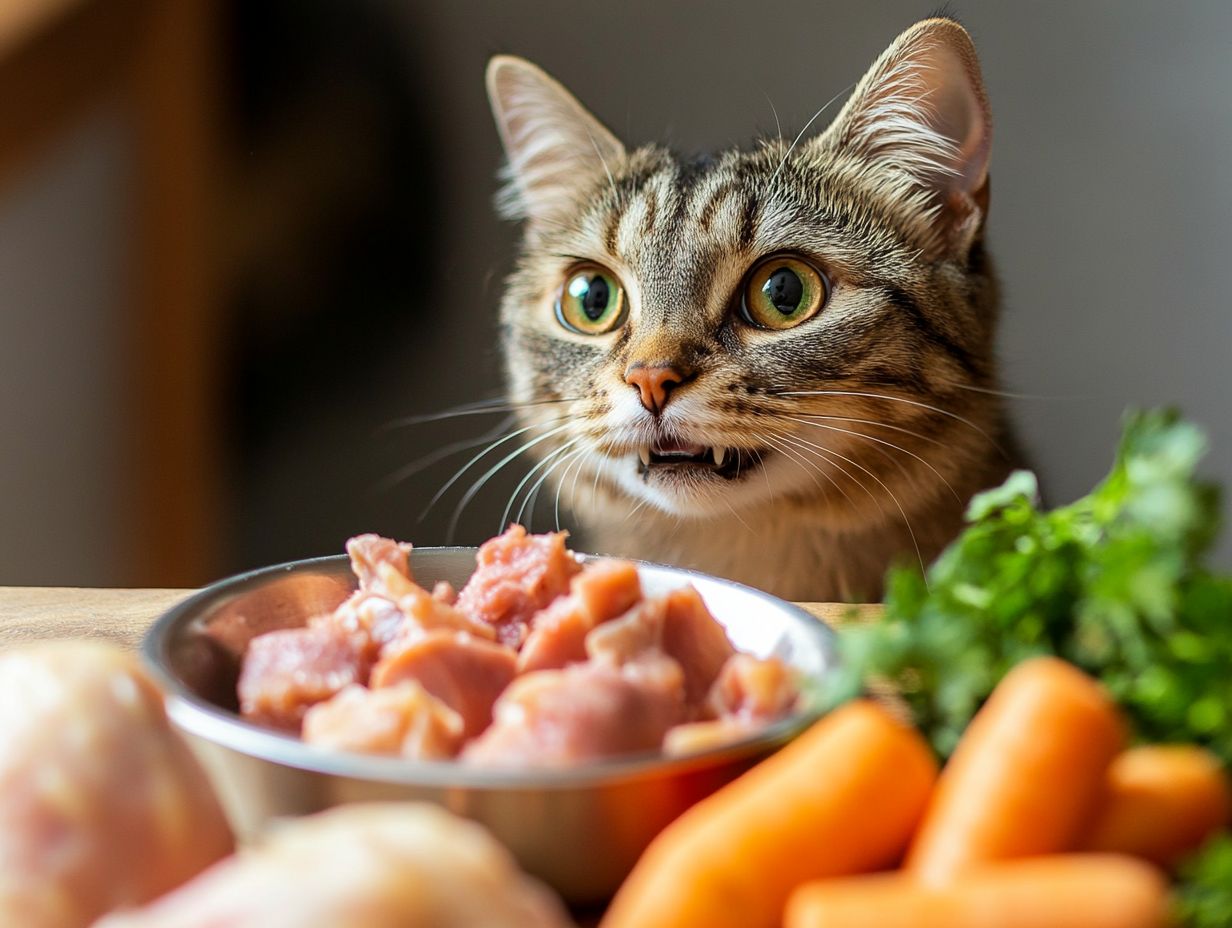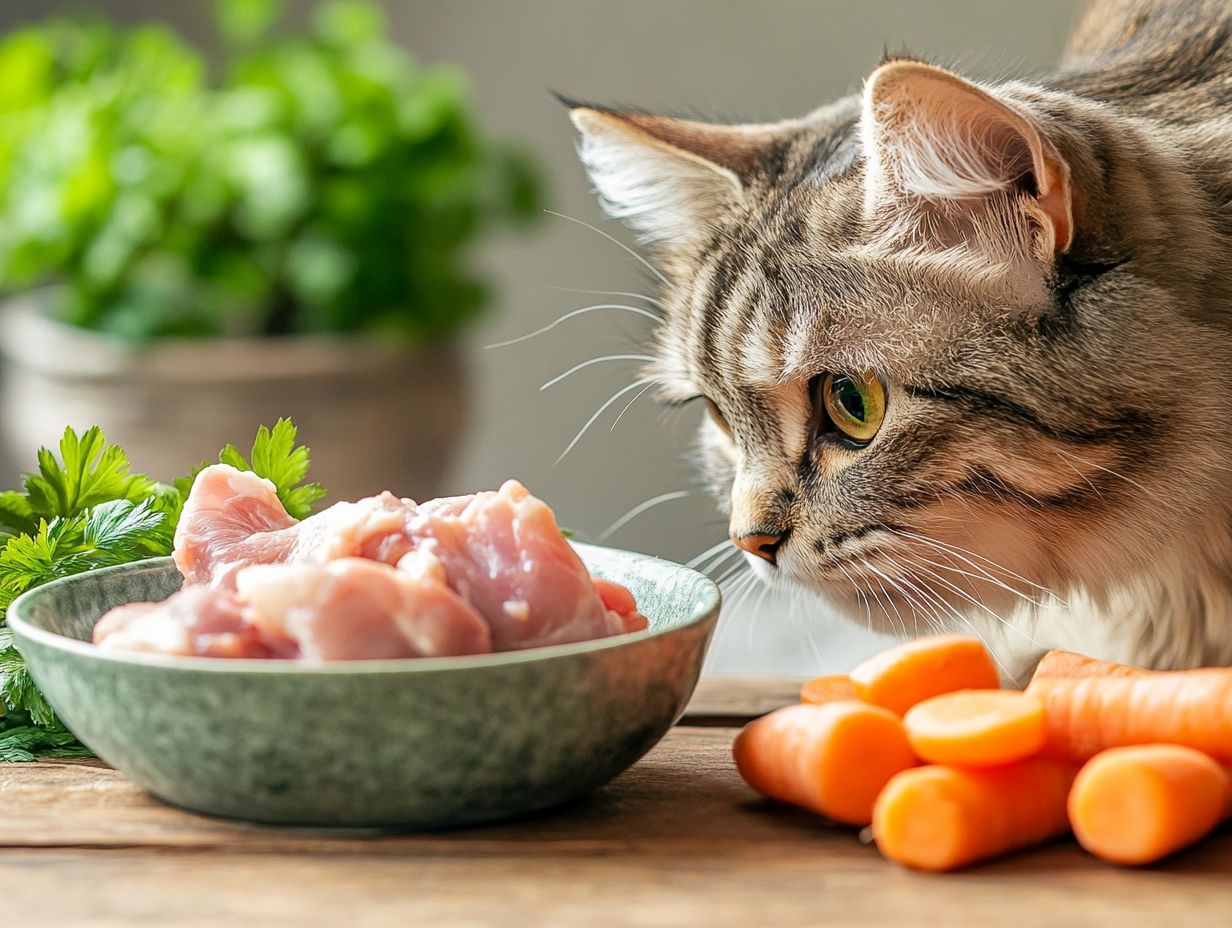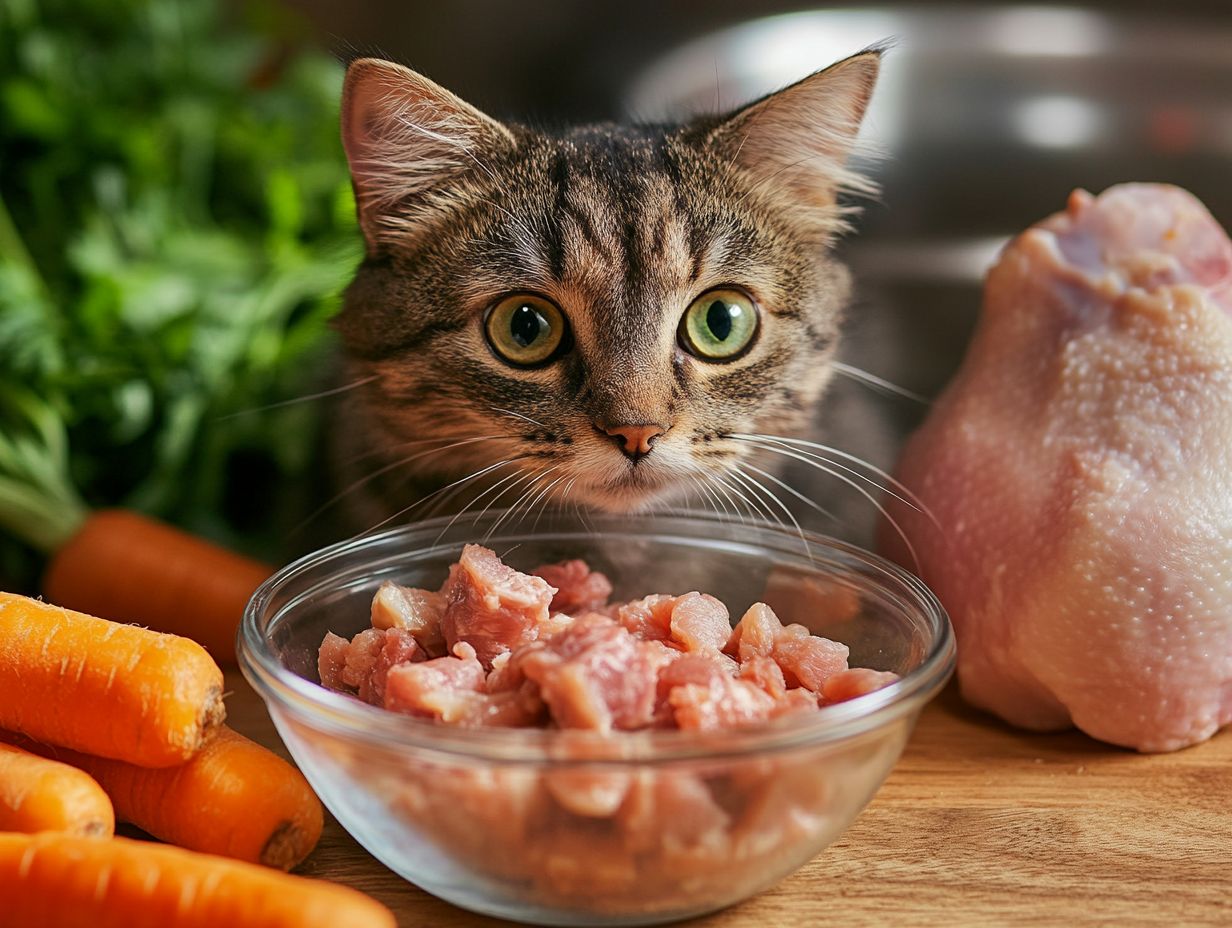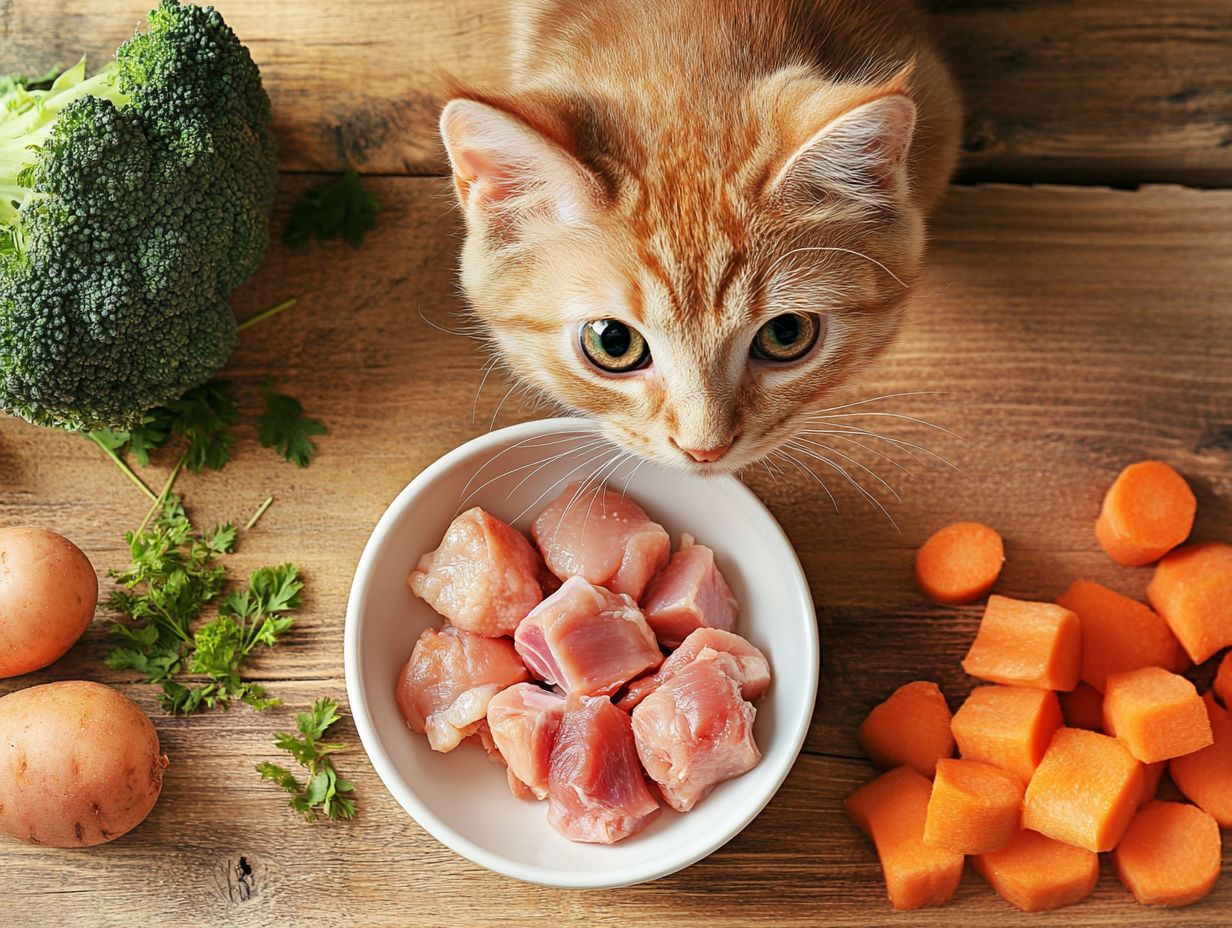Considering feeding your cat a raw cat food diet for your feline friend? You’re not alone—many pet owners are exploring this natural feeding approach, drawn by its potential benefits.
This guide breaks down the essentials of raw cat food diets, explores why some owners make the switch, and discusses the numerous advantages.
It also covers transitioning your cat, what to include or avoid in their meals, and the safety aspects to consider, including proper nutrition and balanced proportions.
Whether you’re curious or committed, this comprehensive guide will provide you with the knowledge to make informed choices for your cat’s health and happiness.
Key Takeaways:

A raw cat food diet can improve digestion, coat and skin health, energy, and dental health in cats.
Transitioning a cat to a raw food diet requires consideration, proper introduction, and overcoming common challenges.
Consulting with a veterinarian is important for ensuring a safe and balanced raw cat food diet.
The Basics of a Raw Cat Food Diet
The basics of a raw cat food diet encompass selecting appropriate raw ingredients and ensuring a balanced, nutritious diet for your cat. As obligate carnivores, cats require diets that are rich in protein, essential nutrients, and amino acids.
This involves not only choosing high-quality raw meat but also selecting ingredients that meet AAFCO standards to create a safe and wholesome diet. Adhering to these guidelines helps prevent issues such as Salmonella, E. coli, and Listeria contamination, which can arise from improperly handled raw animal products.
What Is a Raw Cat Food Diet?
A raw cat food diet consists of uncooked animal products that provide essential proteins, vitamins, and minerals to meet your cat’s nutritional requirements. This approach emphasizes the use of high-quality proteins such as chicken, turkey, and fish, which are vital for muscle development and energy.
Incorporating organ meats, like liver, offers a concentrated source of nutrients that contribute to overall well-being. Another important aspect of this diet is its moisture content, which aids in digestion and hydration—both crucial for kidney health.
Additionally, a raw food diet can enhance your cat’s coat condition, boost their immune system, and promote better dental health, making it a holistic choice for feline nutrition and overall health.
Why Do Some Pet Owners Choose a Raw Cat Food Diet?
Many pet owners cite improved nutritional alignment with natural dietary needs and the resulting enhancements in health and vitality as primary reasons for switching to raw cat food. Their concerns are often linked to the increasing prevalence of obesity, diabetes, and renal disease in domestic cats. Additionally, many owners want to provide a more species-appropriate diet that they believe will boost energy levels and potentially extend their cats’ longevity.
While veterinarians suggest that there may be benefits, such as better skin and coat health, they also caution about the risks of nutritional imbalance and pathogen exposure. The Veterinary Nutrition and Education Consultative Group discusses both the benefits and risks of a raw cat food diet, emphasizing that careful planning with a veterinary nutritionist is essential to meet all of a cat’s nutritional needs.
The Benefits of a Raw Cat Food Diet
The benefits of feeding cats raw food include improved digestibility, healthier skin and coat, increased energy, enhanced dental health, and overall improvement in their wellbeing. The high moisture content and natural enzymes found in raw ingredients can significantly contribute to these benefits.
1. Improved Digestion
One of the primary benefits often associated with a raw cat food diet is improved digestion. The high moisture content and natural enzymes found in raw ingredients can enhance nutrient absorption. In contrast, commercial dry food typically lacks the necessary moisture and essential components, making it more challenging for pets to effectively break down and absorb vital nutrients, vitamins, and minerals.
Risks and Considerations
While raw diets can be beneficial, they must meet AAFCO nutritional standards to avoid deficiencies, especially in essential nutrients like taurine, vitamins, and minerals. Additionally, special dietary considerations should be made for cats with conditions like kidney disease or diabetes, as a raw diet may not be appropriate for these cats without veterinary oversight.
Safety Protocols
It’s crucial to implement proper safety protocols when handling raw food. Always practice safe storage methods, avoid cross-contamination, and follow safe handling guidelines to prevent foodborne illnesses. Additionally, supplements or additives may be necessary in raw diets, which should be discussed with a veterinarian.
Feeding Recommendations
Transitioning your cat to a raw diet requires careful planning. Gradually introduce raw food while monitoring for any signs of digestive distress, such as diarrhea or vomiting. It is essential to consult a veterinary nutritionist throughout this process to ensure that the diet remains balanced and safe.
Lifecycle Considerations
Keep in mind that cats have unique nutritional needs at different life stages, including kittens, pregnant/nursing cats, and senior cats. It’s important to tailor the raw diet accordingly to meet these needs effectively.
The inherent moisture in raw food can aid in digestion by softening food materials for easier passage through the gastrointestinal tract. However, it’s important to note that this does not replace the necessity of clean water for hydration. Adequate hydration is essential for overall health. Additionally, the natural fibers present in raw ingredients promote healthy gut flora and regular bowel movements, while enzymes facilitate nutrient breakdown, helping to prevent common digestive disorders.
This holistic approach to nutrition fosters a more resilient digestive system and promotes better overall health in the long run.
2. Healthier Coat and Skin
A raw cat food diet enhances your cat’s coat and skin condition by supplying high-quality protein and fatty acids that nourish from within. These nutrients are essential for maintaining normal skin function and achieving a shiny coat and moist skin. Research indicates that such diets can improve skin health, with studies showing a correlation between high protein intake and coat quality.
Vitamins A, E, and B-complex vitamins, such as biotin, further improve skin and coat health. Ingredients like fish, chicken liver, and omega-rich oils provide these vital nutrients and promote skin hydration. However, it is critical to ensure that the raw diet is balanced to avoid nutritional deficiencies.
Additionally, raw pumpkin seeds and flaxseed offer extra omega-3 and omega-6 fatty acids, which contribute to a healthy, lustrous coat. This highlights the significant impact of diet on a cat’s outward appearance.
3. Increased Energy and Vitality

Cats on a raw food diet often exhibit increased energy and vitality due to higher protein levels and essential nutrients supporting their active lifestyles. These high-quality proteins are crucial for maintaining lean muscle mass and contributing to overall vigor. Studies have demonstrated that raw diets can lead to improved activity levels in cats.
The caloric density and nutritional value of raw diets ensure that cats receive enough energy to fuel their playfulness and curiosity. While some pet owners have noted positive changes, it is essential to consult scientific literature for a more objective view on the benefits of raw diets.
For instance, one study observed that cats shifted to raw diets showed increased activity levels compared to those on commercial diets. However, it is important to recognize that raw diets also come with potential risks, including the risk of bacterial contamination. Always consult a veterinarian before making significant changes to your cat’s diet.
4. Better Dental Health
One advantage of feeding cats raw food is improved dental health, as the natural chewing action can help reduce tartar and plaque buildup on their teeth. This mechanical scraping action functions similarly to a toothbrush, promoting better gum health and fresher breath. However, it is crucial to note that raw diets do not eliminate the need for regular dental check-ups and professional cleaning.
Additionally, crunchy raw vegetables can further enhance the dental benefits of a raw diet, as their fibrous texture helps clean teeth more thoroughly during chewing. However, it is still essential to regularly monitor your pet’s dental health to ensure they are receiving a balanced raw diet and adequate hydration from clean water.
Supplementing with clean water and occasional dental treats specifically designed for cats can help maintain a comprehensive approach to overall dental health. Consult your veterinarian for specific recommendations on supplements and dosages.
How to Transition Your Cat to a Raw Food Diet
Cat owners should carefully plan for a gradual transition to a raw food diet for their pets, discussing the changes with a veterinarian to ensure a smooth shift to a feeding regimen that prioritizes proper nutrition and meets AAFCO standards.
What to Consider Before Transitioning to a Raw Food Diet
Before transitioning your cat to a raw food diet, it is important to consider their current health status and dietary preferences. Consulting a veterinarian or veterinary nutritionist can provide personalized guidance tailored to your cat’s needs. Factors such as age, existing health conditions, and potential allergies can significantly influence how your feline adjusts to this dietary change.
Kittens have different nutritional requirements than senior cats, and certain health conditions may necessitate restrictions on specific ingredients. It is essential to monitor for any adverse reactions during the transition phase, such as gastrointestinal upset or changes in behavior.
Understanding any food sensitivities or allergies your cat may have can help identify suitable raw food options. Professional assistance can ensure the creation of a balanced diet that meets AAFCO standards, guaranteeing that your pet receives all the essential nutrients for their health. Additionally, it is critical to discuss potential nutritional deficiencies associated with raw diets, ensuring that the diet includes essential vitamins and minerals.
How to Introduce Raw Food to Your Cat
Introducing raw food to your cat should be a gradual process. This allows them to acclimate to new tastes and textures while ensuring that the diet is both palatable and well-accepted. Keep in mind the ethical and safety concerns related to sourcing raw ingredients; ensure they are safe and free from contaminants.
Lastly, cat owners should stay informed about the latest AAFCO and WSAVA guidelines to ensure their feeding practices align with current veterinary nutrition standards.
To facilitate this transition, it is advisable to start by mixing small amounts of raw food with their current diet. This approach helps reduce resistance and enables you to observe feeding behaviors, which can indicate acceptance of the new diet. For more information, check out the Raw Cat Food Diet Explained: What Every Pet Owner Should Know.
It’s important to keep them engaged with the new diet; introducing a variety of flavors and textures can help maintain their interest in the raw food. Depending on the individual cat’s needs, offering different raw proteins and warming the food can enhance palatability. Incorporating homemade raw food options can also increase variety.
Common Challenges and How to Overcome Them
Pet owners often encounter several challenges when transitioning their cats to a raw food diet, including initial resistance from the pets, concerns about balanced nutrition, and safety issues related to handling raw food. Additional difficulties can arise from sourcing high-quality ingredients and adjusting pets’ digestive systems to raw food. For more information about raw cat food, check out the Raw Cat Food Diet Explained: What Every Pet Owner Should Know.
To address these challenges, pet owners should gradually introduce raw food while closely monitoring their pets’ reactions. Ensuring a well-rounded diet, with the appropriate amounts of protein, fats, and essential vitamins, is possible through careful meal planning and guidance from a veterinarian. Consulting a veterinary nutritionist can also provide insights into necessary nutrition considerations.
Proper food safety requires strict adherence to protocols during food preparation, such as sanitizing surfaces and using separate utensils for raw food. It is essential to thaw meat safely, store raw food at safe temperatures, and recognize signs of spoilage. For optimal health, maintaining a balanced diet may involve mixing raw food with cooked options to ensure a wider variety of essential nutrients.
What Foods to Include and Avoid in a Raw Cat Food Diet
Understanding which foods to include and which to avoid when preparing a raw cat food diet is essential for ensuring balanced nutrition and minimizing the risk of foodborne illnesses. However, potential risks of raw diets, such as bacterial contamination and nutritional deficiencies, should be noted. It is crucial to consult a veterinarian before making any significant dietary changes.
Meat and Organ Choices

The selection of meats and organs in raw cat food is designed to provide the essential protein and nutrients necessary for a healthy diet. Incorporating a variety of meats, such as chicken, beef, and turkey, helps ensure a balanced array of amino acids and other nutrients, in line with AAFCO and WSAVA guidelines.
Chicken offers a good source of lean protein, while beef supplies iron and zinc, both of which are crucial for maintaining energy levels and supporting immune function. Additionally, organ meats like liver and heart are concentrated sources of vitamins A and B, as well as taurine, which is vital for heart health.
Vegetables and Fruits for Cats
While cats are obligate carnivores, incorporating small amounts of certain vegetables and fruits into their raw food diet can be beneficial as minor supplements. Vegetables like pumpkin and sweet potato can support digestive health, while leafy greens such as spinach and kale provide important vitamins. However, the primary focus should remain on animal-source proteins.
Fruits like blueberries and melons offer antioxidants and hydration. To enhance digestibility, vegetables should be steamed or pureed before serving. It is important to introduce these additions in moderation, as excessive fiber can negatively impact gastrointestinal health. Additionally, some fruits and vegetables, such as onions and garlic, are toxic to cats and should be strictly avoided.
Supplements for a Balanced Diet
Surveys of raw cat food diets indicate that the most common supplements include omega-3 fatty acids, probiotics, vitamins, and taurine. Taurine is particularly important when the raw diet is not complete and balanced. Pet owners should always consult their veterinarian about the appropriate supplements based on individual cat needs, especially for those with specific health conditions like kidney disease, diabetes, or obesity.
This amino acid is naturally found in meat, although its levels can vary significantly based on the meat’s quality. Due to taurine’s essential role in heart health, especially in cats on raw diets that may lack complete nutrition, supplementation should be considered.
The need for other vitamins, minerals, and amino acids should be assessed on an individual basis, depending on the specific nutritional profile of the raw diet being provided.
Foods to Avoid for Cats
Certain foods are known to be toxic or harmful to cats and must be strictly avoided in any diet, including raw diets. These harmful items include:
- Chocolate, which can lead to severe heart problems and seizures;
- Onions and garlic, which can cause anemia by destroying red blood cells;
- Grapes and raisins, which are linked to kidney failure.
Even small amounts of these foods can trigger severe reactions, making it crucial to educate cat owners about the risks involved. This knowledge is essential for ensuring both the immediate safety and the long-term health and happiness of their cats.
Is a Raw Cat Food Diet Safe?
The safety of a raw cat food diet is a significant concern for pet owners, particularly regarding foodborne pathogens like Salmonella and E. coli, which can pose risks to both feline and human health. Consulting with veterinary professionals before making any dietary changes is highly recommended.
Potential Risks and How to Mitigate Them
The potential dangers of feeding cats raw food include bacterial contamination from pathogens like Salmonella and E. coli, as well as nutritional deficiencies if the diet is not properly formulated; however, these risks can be mitigated through safe preparation and a thorough understanding of dietary needs.
Veterinary professionals emphasize the importance of safe food handling to minimize the risk of contamination and the proliferation of harmful pathogens such as Salmonella and E. coli in raw diets. To prevent cross-contamination, raw foods should be prepared using separate cutting boards and utensils.
Proper storage is equally important; maintaining raw food at consistent, safe temperatures is necessary to inhibit bacterial growth. Additionally, raw diets can lead to deficiencies in essential nutrients such as calcium or potassium if not properly balanced.
Therefore, it is crucial to work with a veterinarian to develop a customized feeding plan that meets all of a cat’s dietary needs while minimizing health risks.
Consulting with a Veterinarian
Veterinarians play a crucial role in a raw cat food diet by providing tailored nutritional support and addressing health concerns related to this type of diet. They possess a comprehensive understanding of the unique dietary needs of each cat, which can vary significantly based on factors such as age, activity level, and pre-existing medical conditions. Additionally, they can help manage health issues such as obesity, diabetes, and renal disease. Regular follow-ups can help ensure that the diet remains appropriate as the cat’s needs change over time.
Veterinarians can assist pet owners in meal planning and monitoring important health metrics to identify potential risks associated with dietary changes early.
Frequently Asked Questions

What is a raw cat food diet?
A raw cat food diet is a diet that consists of raw meat, bones, and organs, as well as some fruits and vegetables. It mimics the natural diet of a wild cat and is believed to provide a more species-appropriate and nutrient-dense diet for domestic cats. The inclusion of sufficient moisture content is crucial for digestion and overall health.
Why should I consider switching my cat to a raw food diet?
Many cat owners choose to switch to a raw food diet because they believe it offers numerous health benefits. These can include improved digestion, healthier skin and coat, fewer allergies, and better overall health and vitality for their cat. Considering commercial food alternatives can also be beneficial for some pet owners.
Is a raw food diet safe for cats?
When done correctly, a raw food diet can be safe and beneficial for cats. It is important to consult with a veterinarian or nutritionist to ensure the diet is balanced and meets your cat’s specific nutritional needs.
What are the potential risks of feeding my cat a raw food diet?
Feeding a raw food diet can present risks such as bacterial contamination and nutritional deficiencies, necessitating proper guidance and monitoring.
What are the unique dietary needs of different life stages for cats?
Cats have varying dietary requirements based on their life stage, such as kittens, senior cats, and pregnant or nursing cats. It is important to tailor their diet accordingly, and consulting a veterinarian can assist in this process.
Important Note: Always use high-quality, safe sources for raw meat to mitigate the risks of contamination.
Some potential risks of feeding your cat a raw food diet include bacterial contamination from specific pathogens such as Salmonella and E. coli, a lack of proper nutrition if not balanced correctly, and potential choking hazards from bones. Both cats and humans can face health implications from these pathogens. It is crucial to properly handle and prepare raw food, following safe food handling practices, and consult with a professional to ensure your cat’s needs are being met. Additionally, raw diets must meet AAFCO standards for nutritional adequacy, and referencing recent studies can provide more information on the benefits and risks associated with raw diets.
How do I switch my cat to a raw food diet?
It is recommended to introduce raw food gradually, mixing it in with your cat’s current diet and slowly increasing the amount over time. This will give your cat’s digestive system time to adjust. It is also important to do your research and consult with a veterinarian or veterinary nutritionist to ensure the diet includes the nutrients cats need. Routine check-ups are advisable to monitor health parameters during this transition.
Can I feed my cat a raw food diet exclusively?
Yes, feeding a raw food diet exclusively is an option, as raw diets are formulated based on cats’ obligate carnivore nature. However, it is essential to ensure the diet is properly balanced to prevent nutritional deficiencies, such as taurine and calcium. Consulting with a veterinarian or nutritionist is recommended to monitor your cat’s health and make necessary adjustments to the diet.
Practical Tips for Feeding Raw
When preparing and storing raw food, keep in mind the following safety tips: store raw food at appropriate temperatures (below 40°F/4°C) and check for signs of spoilage, such as off odors or discoloration. Proper handling will help minimize the risk of contamination.
Addressing Special Dietary Needs
Raw diets may need to be adjusted for cats with specific health conditions like kidney disease or diabetes. Individualized veterinary advice is vital to ensure these dietary adjustments meet your cat’s unique health requirements.